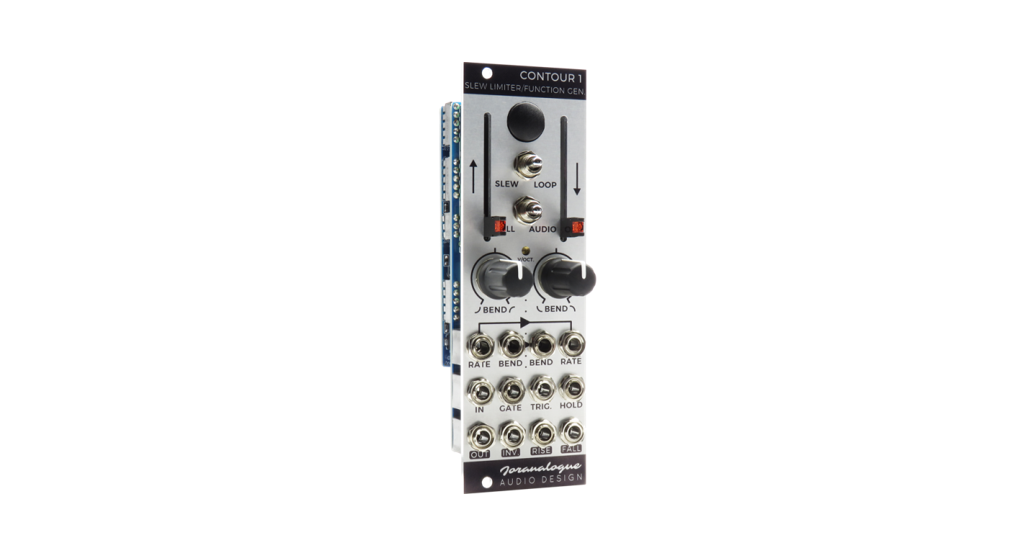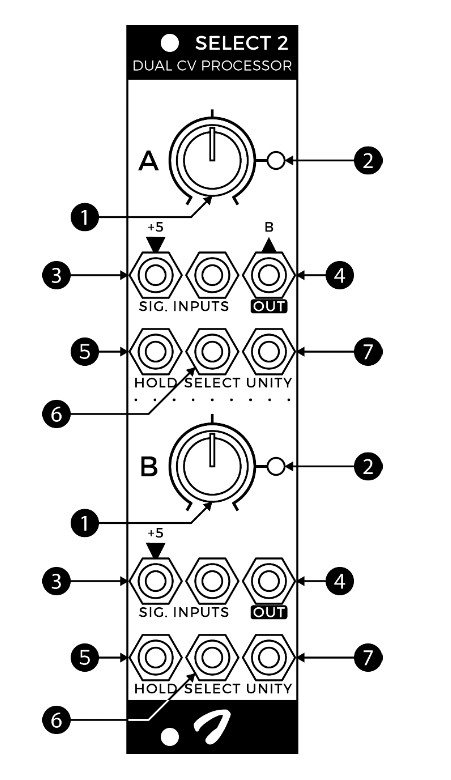
SELECT 2DUAL GATED PRECISION CONTROL VOLTAGE PROCESSOR
INTRODUCTION
A ‘Swiss Army knife for your modular system, Select 2 provides two highly accurate gate-controlled voltage processors in 6 HP. These allow you to create, switch, mute, hold, invert, attenuate, offset, add/mix and subtract voltages, from slow control voltages (CVs) up to audio frequencies. Each processor features two signal inputs, with the left input used by default. A gate on the ‘select’ input switches to the right signal input instead. The signal inputs are normalised to the precision +5 V reference (left) and 0 V (right). Following the input section is a hold circuit. A rising edge on the ‘hold’ input freezes the input voltage at that moment until the gate input goes low again. While most sample/track-and-hold modules only manage a few seconds, Select 2’s ‘low droop’ design enables it to store a held voltage accurately for several minutes. The end of the signal path consists of a gated polariser/attenuverter. Using the knob, the voltage at the output can be attenuated and/or inverted: the gain is −1 (inverted) at the minimum setting, 0 at the centre and +1 (unity gain) at the maximum. The polariser can be disabled using the ‘unity’ gate input. This unique ability enables a variety of interesting gate-controlled signal modulations. Dual-colour LEDs show the output voltage of each processor. Finally, if the A output socket is left unused, the signal is mixed together with the B output. This enables signal offsetting, CV mixing, pitch transposing etc.
CONTENTS
In the Select 2 box, you’ll find:
- Product card, stating serial number and production batch.
- 16-to-10-pin Eurorack power cable.
- Mounting hardware: two black M3 x 6 mm hex screws, two black nylon washers and a hex key.
- The Select 2 module itself, in a protective cotton bag.If any of these items are missing, please contact your dealer or [email protected].
CONTROLS & CONNECTIONS
1. POLARISER KNOBSEach of the identical voltage processors features a knob to control the polariser. The signal is inverted at the minimum setting, fully attenuated (0 V) at the centre and remains unity gain at maximum.
2. OUTPUT LEDSThese bi-colour LEDs visualise the processor output voltages in real-time: blue for negative, red for positive.
3. SIGNAL INPUTSThere are two analogue signal inputs for each processor, with the left input being used by default. For constant voltage generation, simply leave all input sockets unused: the left signal input is normalised to +5 V.
4. OUTPUTSEach processor has an accurate, impedance compensated signal output. If nothing is plugged into the A output socket, its output signal is mixed together with the B output. This allows you to apply an offset to a signal, mix two signals etc.
5. HOLD GATE INPUTSApply a gate signal to the hold input to ‘freeze’ the input voltage. While the hold gate is high, any changes in the signal inputs are ignored. When the gate goes low again, the circuit snaps back to the voltage at the currently selected input. Each processor can thus function as a track-and-hold for both CV and audio. However, the exceptionally low leakage rate also allows minutes-long storage of pitch-accurate CVs. All of Select 2’s gate inputs are uniquely designed to be driven reliably even from weak, slow, bipolar signals. They feature Schmitt action, with a +2 V low and +3 V high logic threshold.
6. SELECT GATE INPUTSThis gate input selects between the processor’s signal inputs: if unused or low, the left signal input is selected. A high gate signal selects the right input instead. Apart from selecting between two inputs, this gated selector switch also allows you to create gate-activated constant voltages or to mute signals.
7. UNITY GATE INPUTSThe unity gate input is used to disable the polariser. When disabled, the output signal simply remains at unity gain, as if the polariser knob would be set to the maximum position.
PATCH IDEAS
GATED CONSTANT VOLTAGE GENERATORIf none of a processor’s signal or gate inputs is used, the +5 V reference voltage is sent to the polariser. Use the knob to generate a manually variable voltage between −5 V and +5 V at the polariser’s output. This is useful for controlling CV inputs without dedicated knobs.This constant voltage can be disabled (switched to 0 V) using the select gate input. When the select gate is active, the right signal input is selected, which is 0 V by default. The output signal can also be switched to +5 V using the unity gate input, which disables the polariser.
GATED ATTENUATOR/POLARISER AND MUTERSimilar to the gated constant voltage generator, except in this application an external signal is connected to the left signal input. Now the knob attenuates and polarizes the signal. Mute it with a select gate, and disable the polariser using the unity gate input.
RING MODULATORSelect 2 can be used to create classic ring modulator tones. Set the knob to the minimum setting and connect your audio-rate carrier and modulator signals to the left signal and unity gate inputs respectively. The modulator should be a square or pulse wave for the best result, as this is a logic input. Use the knob to control the depth of the ring modulator effect.
AUDIO TRACK-AND-HOLDAnother classic synthesiser audio effect is the track-and-hold, creating digital-sounding ‘downsample’ tones using analogue circuitry. Patch Select 2 like the ring modulator, except the modulator, is sent to the hold input. While the hold input is high, the carrier signal is ‘frozen’. Once the hold goes low again, the output snaps to follow the carrier input. Vary the pulse-width of the modulator to sweep from a subtle effect to full-on sample-and-hold.
VARIABLE WAVEMORPHERConnect two different waveshapes from an oscillator (for example, sine and saw) to the two signal inputs, and the oscillator’s pulse output to the select gate input. The result is a morphed signal, where each waveshape makes up part of the total period. By adjusting the oscillator’s pulse-width parameter, the morphing can be varied.
SEQUENCE SELECTORPatch two CV sequences to both signal inputs, and a gate sequence to the select gate input, all driven from the same clock. Now the gate sequence selects between both CV sequences: left when low, right when high. Easily create new hybrid melodies just by changing the gate sequence.
ATTENUATOR/POLARIZER AND OFFSETThanks to the mixing feature, both sections can be used together to both attenuate/polarise and offset a signal. Simply plug your signal into the left B input. The A knob controls the −5 V to +5 V offset, while the B knob controls the attenuation and polarisation. This method also allows −10 V to +10 V constant voltages to be generated from the bottom processor, when all inputs are unused.
GATE-TO-AUDIO CONVERTERIf you have an audio-rate gate signal (switching between 0 V and +5 V), you can convert it to a standard zero-centred 10 Vpp (−5 to +5 V) signal using Select 2. Set one of the knobs to the minimum setting, plug your signal into the corresponding unity gate input, and leave all other inputs on that section unused. The output signal is a 10 Vpp square wave, not inverted with respect to the original gate signal.
SPECIFICATIONS
MODULE FORMATDoepfer A-100 ‘Eurorack’ compatible module3 U, 6 HP, 30 mm deep (inc. power cable)Milled 2 mm aluminium front panel with nonerasable graphics
MAXIMUM CURRENT DRAW+12 V: 25 mA−12 V: 25 mA
POWER PROTECTIONReverse polarity (MOSFET)
I/O IMPEDANCEAll inputs: 100 kΩAll outputs: 0 Ω (compensated)
DC VOLTAGE ERROR0.3 % maximum
BANDWIDTH25 kHz (−1 dB)
OUTER DIMENSIONS128.5 x 30 x 43 mm (H x W x D)
MASSModule: 80gIncluding packaging and accessories: 165g
SUPPORT
As all Joranalogue Audio Design products, Select 2 is designed, manufactured and tested with the highest standards, to provide the performance and reliability music professionals expect.In case your module isn’t functioning as it should, make sure to check your Eurorack power supply and all connections first. If the problem persists, contact your dealer or send an email to [email protected]. Please mention your serial number, which can be found on the product card or on the module’s rear side.
REVISION HISTORY
Revision E: no functional changes.Revision D: initial release.
With compliments to the following fine people,who helped to make Select 2 a reality!
Ben ‘DivKid’ Wilson Björn JaussBoris Uytterhaegen Gregory DelabelleJan D’Hooghe Jens Van DaeleLieven Stockx Sebastiaan TulkensEveryone at Wired Electronics
Select 2 User Manualversion 2019-07-1521 st Century Analogue Synthesis—Made in Belgium© 2018—2019 [email protected]https://joranalogue.com/
[email protected]https://joranalogue.com/
[xyz-ips snippet=”download-snippet”]


